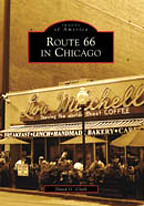If any person should publish a Route 66 book about the Windy City, David G. Clark is one. And that’s what he and Arcadia Publishing have done with “Route 66 in Chicago” ($19.95, 128 pages).
However, I would first recommend his other book about the Mother Road. More on that later.
“”Route 66 in Chicago” is lavishly illustrated with hundreds of vintage and current-day photos and drawings of the city’s historical sites and architecture, with many of the images from Clark’s own collection.
photos and drawings of the city’s historical sites and architecture, with many of the images from Clark’s own collection.
Clark’s love of history is evident and deep. For him, the roots of Route 66 don’t begin when the road was certified in 1926. They go back centuries, when Louis Joliet and Jacques Marquette explored the area, and later in the 1800s, when farmers and businessmen had to figure out how to transport their goods to Chicago. At first, it was by rivers, canals and stagecoach trails. Then the railroads came. Then the roads. All of these modes of transportation tended to overlap each other over time and blazed the way for future alignments of Route 66.
Whoever reads “Route 66 in Chicago” probably will learn a few things about the City with Big Shoulders. For instance, there once was a quagmire called Mud Lake that was part of the Portage Trail between the Chicago and Des Plaines rivers. The lake was navigable by small canoe only 45 days a year; the rest of the time it was mud. (Mud Lake eventually dried up when development altered the water table.)
The “Serving the Traveler” and “Surviving the Interstates” chapters will likely be most useful for Route 66 travelers. They point out historic hotels, restaurants and other landmarks that once existed or still remain on the Mother Road.
“Route 66 in Chicago” proves to be a worthwhile historical undertaking. However, Clark’s earlier book, “Exploring Route 66 in Chicagoland,” is more practical for Mother Road wanderers and comes highly recommended. “Route 66 in Chicago” is more of a companion volume.